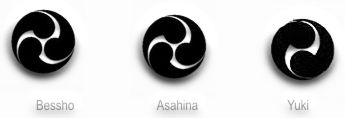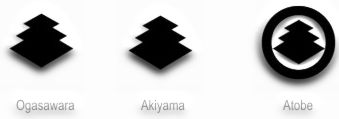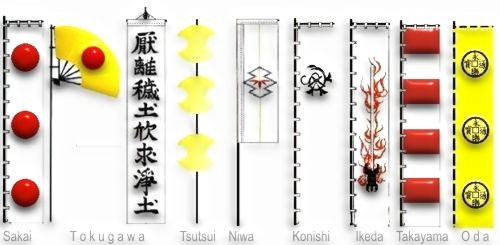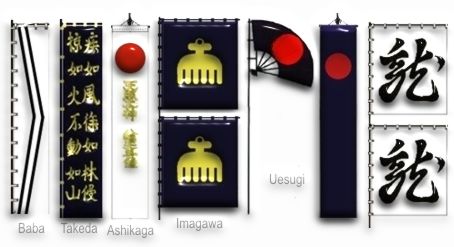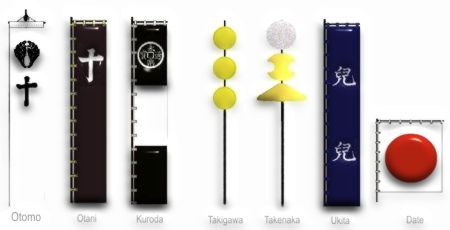| CRESTS OF JAPANESE WARLORDS' CLANS 4 |
| PAGE 1 | PAGE 2 | PAGE 3 | PAGE 4 |
Some samurai family crests, despite the accidental similarities or even duplicity, were sort of unique enough. Browse over those belonging to the great clan of Saito, the infamous Akechi, the low-profiled Aki, the splashing Sagara, the well-known Okudaira, the sturdy Ouchi and the one American World War veterans never forgot all their lives: the Togo.
Some other crests are designed in perfection, some others are rather fuzzy in logic, and some are indescribable, among the non-copious ones. Here are the coats of arms of the clans bearing the names of Ota, Yamanouchi, Ijuin, Muneshige, Suwa, Konishi, Oyamada and Torii. While most caucasians have been consistently mistaken the crest of the Buddhist Shimazu clan's as one of a Christian samurai family (click the name for pictures), this crucifix-like of the crest invented by Konishi Yukinaga is really a cross. He's one of the most famous Christian warlords of all times.
Another famous Christian warlord clan, Otomo, shared a similar crest with the Nabeshima clan, while the anti-Christian warlord Kato Kiyomasa's crest was like the one belonging to the Amano family:
The tragic samurai hero Bessho Nagaharu's crest was similar with the Yuki clan's and looks no different from the Asahina's:
While Ogasawara, Akiyama and Atobe show similarities in their crests, too:
Now here are the personal battle-banners and battle-standards of the clans under Oda Nobunaga's overlordship between 1560 and 1582: the Yamashiro warlord Tsutsui Junkei, one of Oda's best Generals (and in-laws) Niwa Nagahide, Konishi Yukinaga's personal banner (he served Oda by extension via Toyotomi Hideyoshi's regiments), Oda's brother in-law Ikeda Nobuteru, and the most-famous among the best-known Christian warlords, Takayama Ukon. The curious symbol on Konishi's banner is an emblem of filial piety, one of the 'seven virtues' in Bushido -- that was a pic he lifted up from his daddy's shop-sign. The senior Konishi kept a drugstore. Although everybody knew Konishi was a 'parvenu samurai' just like his boss Toyotomi was, he has been revered for the last 500 years as a paragon of ultimate samurainess -- something that is beyond any speck of doubt (click here for Konishi's picture and story). At the left is the personal banner of Tokugawa clan's best Captain Sakai Tadatsugu and Tokugawa Ieyasu's standard and personal banner.
And here are those belonging to the warlords who never loved Oda, and vice versa, except perhaps Uesugi Kenshin of Echigo: the legendary Takeda General Baba Nobufusa, Takeda Shingen's personal banner, Shogun Ashikaga Yoshiaki's, and Imagawa Yoshimoto's.
And here are others': Otomo Sorin's personal banner (he added a crucifix to accompany his clan's crest), Otani's, Kuroda Kanbei's (he appropriated Oda Nobunaga's 'trademark' Chinese coin), another Oda's man, Captain Takigawa Kazumasu's standard, Toyotomi's advisor Takenaka Hanbei's, his opponent Ukita Naoie's, and the arrogation of the rising sun by the headstrong Date Masamune of Sendai.
When the world entered the 21st century, the fuss over origins and meanings of Japanese family or clan crests seemed to be reserved for foreigners plagued by nostalgic outlook and archaic concerns. Modern and postmodern Japanese never cares about family crests in real life; unless, of course, they got emails from nosy foreigners plagued by nostalgic outlook and archaic concerns. But click here for the system of thought of the Japanese since time immemorial, that made all these family crests to mean more than themselves. |
| Samurai Crests 3 | Flowers | Bushido |
|
Site & Rap © 1996, 1997, 1998, 1999, 2000, 2001, 2002, 2003, 2004, 2005, 2006 Nina Wilhemina
All rights reserved. Every borrowed image at this site is put for non-profit educational purposes only.
HOME
 LINKS
LINKS
 CONTACT
CONTACT
 CREDITS
CREDITS
 COMMENTS
COMMENTS
Sources tapped for this page: Nihon Shakai no Kazoku teki Kosei (Tokyo: 1948); Kono Shozo, Kokumin Dotoku Yoron (Tokyo: 1935); Anesaki Masaharu, Nichiren, the Buddhist Prophet (Cambridge, Mass.: Harvard University Press, 1916); Robert Cornell Armstrong, Light from the East, Studies of Japanese Confucianism (University of Toronto, Canada, 1914); Sasama Yoshihiko, Nihon kassen zuten (Yuzankaku, 1997); William Aston, Shinto: The Way of the Gods (London: Longmans, Green, 1905); Ruth Benedict, The Chrysanthemum and the Sword (Boston: Houghton Mifflin, 1946); Charles Eliot, Japanese Buddhism (London, 1935); Futaki Kenichi, Chuusei buke no saho (Yoshikawa Kobunkan, 1999); Kiyooka Eichii, The Autobiography of Fukuzawa Yukichi (Tokyo, Hokuseido Press, 1934); Konno Nobuo, Kamakura bushi monogatari (Kawade shobo shinsha, 1997); Nukariya Kaiten, The Religion of the Samurai (London: Luzac, 1913); A.L. Sadler, The Beginner's Book of Bushido by Daidoji Yuzan (Tokyo: Kokusai Bunka Shinkokai, 1941); A.L. Sadler, The Makers of Modern Japan (Tokyo: Tuttle, 1978); Satomi Kishio, Nichirenism and the Japanese National Principles (NY: Dutton, 1924); Suzuki D.T., Zen Buddhism and Its Influence on Japanese Culture (Kyoto: The Eastern Buddhist Society, 1938); Henri Van Straelen, Yoshida Shoin (Leiden: Brill, 1952); Robert Bellah, Tokugawa Religion; Sato Hiroaki, Legends of the Samurai (Overlook Press, 1995); Masaaki Takahashi, Bushi no seiritsu: Bushizo no soshutsu (Tokyo: Tokyo daigaku, 1999); Stephen Turnbull, Samurai Warlords (London: Blandford Publishing, 1992); Paul Akamatsu, Meiji 1868, Revolution and Counter-Revolution (Allen & Unwin, 1972); Nitobe Inazo, Bushido, The Soul of Japan (Tokyo: Tuttle, 1970); Paul Varley and Ivan Morris, The Samurai (Weidenfeld, 1970); Inoguchi and Nakajima, The Divine Wind: Japanese Kamikaze Force in World War II (Hutchinson, 1959), Seki Yukihiko, Bushi no tanjo (Tokyo: NHK, 2000); Amino Yoshihiko, ed. Edojidai no mikataga kawaruho (Tokyo: Yosensha, 1998). |




